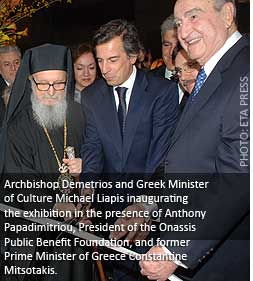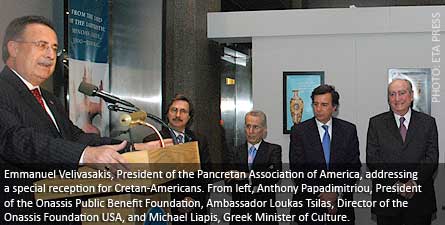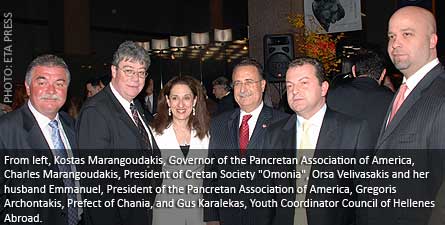Minoan Crete Europe's first civilization,
on display at The Onassis Cultural Center
More than 280 artifacts from the ancient land of Crete, most of which have never been shown outside of Greece, are on display at the New York City’s Onassis Cultural Center . “From the Land of the Labyrinth: Minoan Crete, 3000 – 1100 BC” features a wide range of rare objects revealing the history of Crete’s luminous Minoan civilization, the first fully-developed culture to establish itself on European soil. On view through September 13, 2008, the exhibition uses ancient artifacts and works of art to reveal aspects of daily life in the Minoan civilization—including social structure, communications, bureaucratic organization, religion and technology—during the second and third millennia B.C.
 The exhibition, warmly embraced by the Pancretan Association of America – an entity that engulfs thousands of Americans of Cretan decent across the US - is presented in collaboration with the Hellenic Ministry of Culture. An inaugurating reception, hosted by Anthony S. Papadimitriou, President of the Alexander S. Onassis Public Benefit Foundation, was held at the Olympic Atrium, in the presence of Michael Liapis, Greek Minister of Culture who cut the ribbon, Archbishop Demetrios of America, former Prime Minister of Greece Kostantinos Mitsotakis, Ambassador of Greece to the US Alexandros Mallias, Ambassador Michael Soterhos, Ambassador Loukas Tsilas, Onassis Cultural Center (USA) Director, Governor of Crete Serapheim Tsokas, Prefect of Chania Gregory Archontakis, Member of Parliament representing Herakleion Lefteris Avgenakis, Dr. John Brademas, President Emeritus of NYU, Andrew Athens, former President of Council of Hellenes Abroad, Mr and Mrs Peter J. Goulandris, Eugene Rossides, Chairman American Hellenic Institute, John Catsimatides President and CEO of Red Apple Group, Emmanuel Velivassakis, President of the Pancretan Association, Stavros Semanderes, President of the World Council of Cretans and Charles Marangoudakis, President of the New York Cretan Society “Omonia,” among others.
The exhibition, warmly embraced by the Pancretan Association of America – an entity that engulfs thousands of Americans of Cretan decent across the US - is presented in collaboration with the Hellenic Ministry of Culture. An inaugurating reception, hosted by Anthony S. Papadimitriou, President of the Alexander S. Onassis Public Benefit Foundation, was held at the Olympic Atrium, in the presence of Michael Liapis, Greek Minister of Culture who cut the ribbon, Archbishop Demetrios of America, former Prime Minister of Greece Kostantinos Mitsotakis, Ambassador of Greece to the US Alexandros Mallias, Ambassador Michael Soterhos, Ambassador Loukas Tsilas, Onassis Cultural Center (USA) Director, Governor of Crete Serapheim Tsokas, Prefect of Chania Gregory Archontakis, Member of Parliament representing Herakleion Lefteris Avgenakis, Dr. John Brademas, President Emeritus of NYU, Andrew Athens, former President of Council of Hellenes Abroad, Mr and Mrs Peter J. Goulandris, Eugene Rossides, Chairman American Hellenic Institute, John Catsimatides President and CEO of Red Apple Group, Emmanuel Velivassakis, President of the Pancretan Association, Stavros Semanderes, President of the World Council of Cretans and Charles Marangoudakis, President of the New York Cretan Society “Omonia,” among others.
“From the Land of the Labyrinth: Minoan Crete, 3000 – 1100 BC” was organized by Dr. Maria Andreadaki-Vlazaki, Vili Apostolakou, Christos Boulotis, Nota Dimopoulou-Rethemiotaki, Lefteris Platon, and Giorgos Rethemiotakis.

The exhibition chronologically maps 11 thematic sections covering the establishment and great achievements of the Minoan culture. As the first advanced civilization to arise in the European region, the exhibition explores the historical and cultural context of this celebrated society, and sheds light on its mystery. Information gathered from studies of the Early, Middle, and Late Minoan periods—also referred to as the Prepalatial, Protopalatial, Neopalatial and Postpalatial periods—is derived mostly from objects excavated from the island’s burial grounds and settlements. It is known that Minoan civilization was named after the legendary King Minos of Knossos, who commissioned the Labyrinth, a mazelike structure made famous in Greek mythology. Through each themed-section, the exhibition will piece together the culture’s past with objects—such as the gold jewelry deposited in the rich tombs of the elite, the inscribed clay tablets that disclose the fundamentals of the Minoan economy, ceremonial vessels found in the palaces and tombs, and votive figures of clay as symbolic offerings to protective deities—on loan exclusively from the archaeological museums in Crete, in collaboration with the Hellenic Ministry of Culture.

The Alexander S. Onassis Public Benefit Foundation (USA) and the Onassis Cultural Center are located in Olympic Tower in the heart of midtown Manhattan, at 645 Fifth Avenue, entrances on 51st and 52nd Streets, between Madison and Fifth Avenues.